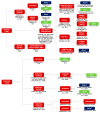Mapping the Neural Substrates of Cocaine Craving: A Systematic Review
- PMID: 38671981
- PMCID: PMC11048489
- DOI: 10.3390/brainsci14040329
Mapping the Neural Substrates of Cocaine Craving: A Systematic Review
Abstract
Craving is one of the most important symptoms of cocaine use disorder (CUD) since it contributes to the relapse and persistence of such disorder. This systematic review aimed to investigate which brain regions are modulated during cocaine craving. The articles were obtained through searches in the Google Scholar, Regional BVS Portal, PubMed, and Scielo databases. Overall, there was a selection of 36 studies with 1574 individuals, the majority being participants with CUD, whereby about 61.56% were individuals with CUD and 38.44% were controls (mean age = 40.4 years). Besides the methodological points, the neurobiological investigations comprised fMRI (58.34%) and PET (38.89%). The induction of cocaine craving was studied using different methods: exposure to cocaine cues (69.45%), stressful stimuli, food cues, and methylphenidate. Brain activations demonstrated widespread activity across the frontal, parietal, temporal, and occipital lobes, basal ganglia, diencephalon, brainstem, and the limbic system. In addition to abnormalities in prefrontal cortex activity, abnormalities in various other brain regions' activity contribute to the elucidation of the neurobiology of cocaine craving. Abnormalities in brain activity are justified not only by the dysfunction of dopaminergic pathways but also of the glutamatergic and noradrenergic pathways, and distinct ways of inducing craving demonstrated the involvement of distinct brain circuits and regions.
Keywords: cocaine; craving; neurobiology; neuroimaging.
Conflict of interest statement
The authors declare no conflicts of interest, and the funders had no role in the design of the study; in the collection, analyses, or interpretation of data; in the writing of the manuscript; or in the decision to publish the results.
Figures





Similar articles
-
Neural correlates of craving and impulsivity in abstinent former cocaine users: Towards biomarkers of relapse risk.Neuropharmacology. 2014 Oct;85:461-70. doi: 10.1016/j.neuropharm.2014.05.011. Epub 2014 Jun 18. Neuropharmacology. 2014. PMID: 24951856 Free PMC article.
-
Methylphenidate attenuates limbic brain inhibition after cocaine-cues exposure in cocaine abusers.PLoS One. 2010 Jul 9;5(7):e11509. doi: 10.1371/journal.pone.0011509. PLoS One. 2010. PMID: 20634975 Free PMC article. Clinical Trial.
-
Acute effects of cocaine on human brain activity and emotion.Neuron. 1997 Sep;19(3):591-611. doi: 10.1016/s0896-6273(00)80374-8. Neuron. 1997. PMID: 9331351 Clinical Trial.
-
Transcranial magnetic stimulation and neuroimaging for cocaine use disorder: Review and future directions.Am J Drug Alcohol Abuse. 2021 Mar 4;47(2):144-153. doi: 10.1080/00952990.2020.1841784. Epub 2020 Nov 20. Am J Drug Alcohol Abuse. 2021. PMID: 33216666 Review.
-
The clinical neurobiology of drug craving.Curr Opin Neurobiol. 2013 Aug;23(4):649-54. doi: 10.1016/j.conb.2013.05.001. Epub 2013 Jun 10. Curr Opin Neurobiol. 2013. PMID: 23764204 Free PMC article. Review.
Cited by
-
Understanding Altered Dynamics in Cocaine Use Disorder Through State Transitions Mediated by Artificial Perturbations.Brain Sci. 2025 Feb 28;15(3):263. doi: 10.3390/brainsci15030263. Brain Sci. 2025. PMID: 40149783 Free PMC article.
References
-
- United Nations Office on Drugs and Crime . Executive Summary: Policy Implications. United Nations Office on Drugs and Crime; New York, NY, USA: 2021.
-
- Bachi K., Mani V., Kaufman A.E., Alie N., Goldstein R.Z., Fayad Z.A., Alia-Klein N. Imaging Plaque Inflammation in Asymptomatic Cocaine Addicted Individuals with Simultaneous Positron Emission Tomography/Magnetic Resonance Imaging. World J. Radiol. 2019;11:62–73. doi: 10.4329/wjr.v11.i5.62. - DOI - PMC - PubMed
-
- United Nations Office on Drugs and Crime . Drug Market Trends of Cocaine, Amphetamine-Type Stimulants and New Psychoactive Substances. United Nations Office on Drugs and Crime; New York, NY, USA: 2022.
-
- Substance Abuse and Mental Health Services Administration (US) Office of the Surgeon General (US) Facing Addiction in America: The Surgeon General’s Report on Alcohol, Drugs, and Health. US Department of Health and Human Services; Washington, DC, USA: 2016. The Neurobiology of Substance Use, Misuse, and Addiction; pp. 1–31.
Publication types
Grants and funding
LinkOut - more resources
Full Text Sources

